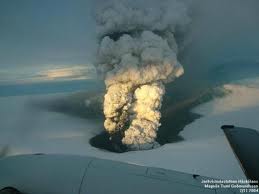
 Last year, Europe suffered a major blow to its airline industry when the eruption of Iceland’s Eyjafjallajökull volcano spread ash across the continent and closed much of its airspace. This past Saturday, Iceland’s most active volcano, Grímsvötn, erupted in what is believed to be far more powerful than that of Eyjafjallajökull. Estimates are that Grímsvötn produced between 100 and 1,000 times more material per second when it exploded and the generated plume was twice as high as Eyjafjallajökull’s, extending 12 miles into the air.
Last year, Europe suffered a major blow to its airline industry when the eruption of Iceland’s Eyjafjallajökull volcano spread ash across the continent and closed much of its airspace. This past Saturday, Iceland’s most active volcano, Grímsvötn, erupted in what is believed to be far more powerful than that of Eyjafjallajökull. Estimates are that Grímsvötn produced between 100 and 1,000 times more material per second when it exploded and the generated plume was twice as high as Eyjafjallajökull’s, extending 12 miles into the air.
Flights to and from Iceland were cancelled yesterday and Reykjavik airport is expected to remain closed today. Ash could reach Scotland by tomorrow and southern Europe by the end of the week. Eurocontrol, Europe’s air safety organization, reportedly issued a statement confirming that “some ash cloud may reach parts of northern Europe in the next 48 hours.”
However authorities are saying any disruptions to air flights will not be in any way as severe as last year. New rules have apparently been implemented in Europe which state that flights will only be grounded when the concentration levels of ash reach significant levels.
Euronews – May 23/2011
Airlines warned Icelandic volcano ash cloud could spread
Europe has been put on alert for some travel disruption following an eruption by Iceland’s most active volcano. Experts, however, say there is little chance of a repeat of last year’s six day closure of airspace when another Icelandic volcano erupted, although airlines have been warned the new ash cloud will drift. So far, Iceland, particularly the towns and villages to the south and east of the Grimsvotn volcano, have suffered most. The thick cloud of ash has drifted over the capital Reykjavik, forcing the closure of the main international airport.
Russia Today – May 22/2011
Video of Iceland volcano eruption, giant ash clouds from Grimsvotn
Iceland’s imposed a flight ban and closed its main airport after the country’s most active volcano, Grimsvotn, erupted. It lies under the uninhabited Vatnajokull glacier in southeast Iceland and has been dormant for 7 years. A large plume of smoke and ash is stretching 20 km into the air. Iceland’s Meteorological Office says that the eruption at the Grimsvotn volcano has been accompanied by a series of small earthquakes. Scientists have been expecting a new eruption and have said previously that this volcano’s eruption will likely be small and should not lead to the air travel chaos caused in April 2010 by ash from the Eyjafjallajokul volcano.
http://www.youtube.com/watch?v=oMStcqHfwQ4
References
Wikipedia: Grímsvötn
Harmonic tremors were recorded twice around Grímsvötn on 2 and 3 October 2010, possibly indicating an impending eruption. At the same time, sudden inflation was measured by GPS in the volcano, indicating magma movement under the mountain. On 1 November 2010 meltwater from the Vatnajökull glacier was flowing into the lake, suggesting that an eruption of the underlying volcano might be imminent.
On 21 May 2011 at 19:25 UTC, an eruption began, with 12 km (7.5 mi) high plumes accompanied by multiple earthquakes. The ash cloud from the eruption rose to 20km/12 miles, and is so far 10 times larger than the 2004 eruption, and the strongest in Grímsvötn for 100 years. During 22 May the ash plume fell to around 10 km altitude, rising occasionally to 15 km.
Wikipedia: Eyjafjallajökull
On 14 April 2010 Eyjafjallajökull resumed erupting after a brief pause, this time from the top crater in the centre of the glacier, causing meltwater floods (also known as jökulhlaup) to rush down the nearby rivers, and requiring 800 people to be evacuated. This eruption was explosive in nature, due to melt water getting into the volcanic vent. It is estimated to be ten to twenty times larger than the previous one in Fimmvörðuháls. This second eruption threw volcanic ash several kilometres up in the atmosphere which led to air travel disruption in northwest Europe for six days from 15 April and in May 2010, including the closure of airspace over many parts of Europe.
Click HERE to read more from William Belle
Article viewed at: Oye! Times at www.oyetimes.com

Be the first to comment